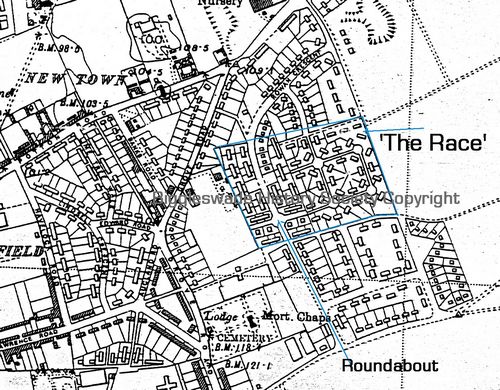A Brief Note About “The Race” Hutments, Biggleswade
|
|||||||||
| The location known as ‘The Race’ comprised hutments that were provided by the Ministry for Housing and Local Government during the 1939-45 war to meet the demand for housing as materials were in short supply. One of the major purposes was to house people who were needed in key locations to work in key industries for the war effort. Companies in Biggleswade, such as Smart & Brown and Pobjoys, were engineering companies who made significant contributions.
The origin of the location being called ‘The Race’ is speculative at present. However, the most likely reason is that a local man of some prominence was one George Race who owned ‘Road Farm’ located on the Potton Road on the eastern edge of the town. This has not been researched but he may have owned the land that the hutments were built on or he may have been a member of the local council and have some influence. Some research in the Biggleswade Chronicle may reveal the truth. This map of 1948 shows the boundary of the hutment settlement.
The hutments were demolished in 1955 in four phases and replaced by houses that included a lot of prefabricated concrete as well prefabricated bungalows. The contractor was Winton Hayes. The replacement properties are still in place but those that were still Council-owned have been upgraded by having brick skins built around them or had external insulation applied. The named locations now occupying the area are Rowan Crescent, Glebe Road, Sutton Avenue, South Walk, East Walk and West Walk.
Supplementary Information 39. Mr. Sorensen asked the Minister of Health how many two-year prefabricated or Nissen huts have now been relinquished by his Department, and how many remain; to what extent they have deteriorated and are becoming uninhabitable; what grant is made to enable local authorities to deal with deterioration; and, in view of the continuing need, what 554 steps he has taken to ensure that these temporary dwellings shall not be closed or relinquished for some time to come. Mr. Bevan 40. Mr. Lennox-Boyd asked the Minister of Health if he is aware that the Biggleswade Rural District Council is receiving applications for houses at the rate of 200 a year, while he has given permission for only 40 houses to be built in the current half-year; and whether he will increase this allocation to enable the numerous applicants on the waiting list to be rehoused more quickly. Mr. Bevan Mr. Lennox-Boyd Mr. Bevan Mr. Lennox-Boyd Mr. Bevan Here is another excerpt from Hansard 19 May 1953: Wartime Camps and Hutments 23. Commander Maitland asked the Minister of Housing and Local Government what special guidance he has given to local authorities to assist them in dealing with the problems which must inevitably occur while people are living in wartime camps and hutments. Mr. H. Macmillan Commander Maitland Mr. Macmillan 24. Commander Maitland asked the Minister of Housing and Local Government how many wartime camps or hutments are still being used by local authorities in England and Wales to house families; and how many people are still living in these camps. Mr. H. Macmillan |
Biggleswade History Society
History of the Bedfordshire market town of Biggleswade

 The first evidence, in the School Admission Registers, of children going to school from there was 1942 and the last child admitted with that address was in 1954. The highest address number found here was No 70.
The first evidence, in the School Admission Registers, of children going to school from there was 1942 and the last child admitted with that address was in 1954. The highest address number found here was No 70.